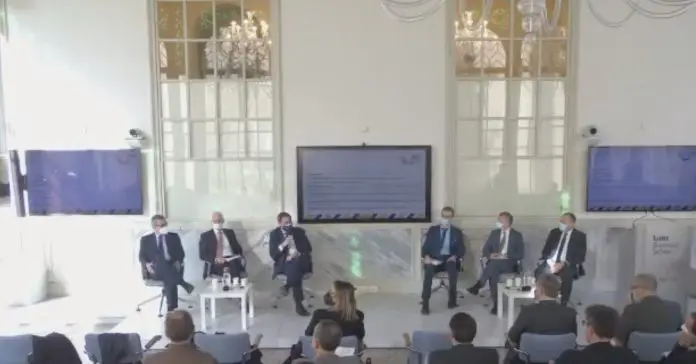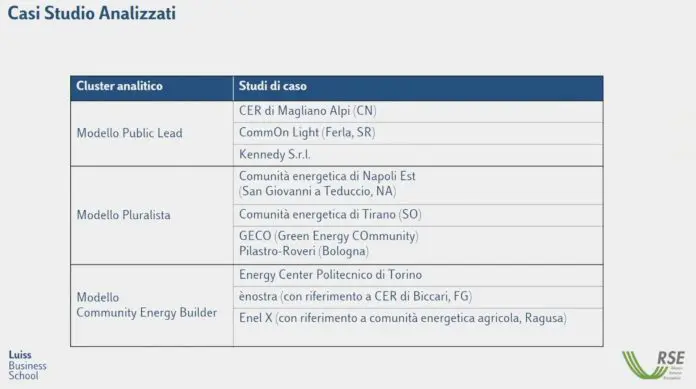Energy Communities as a Leverage for Economic Development for the Transition – First National Conference
16 November 2021Source: repubblica.it – The Hills of Ecological Transition: 15 Municipalities Allied for Energy
16 November 2022RSE and Luiss Business School presented in Rome the results of the mapping project of the 24 initiatives accredited or in the process of being accredited by the GSE, aiming to become the first energy communities in Italy. Together with institutions and key players in national experiences, they highlighted untapped potential and critical issues to be addressed.

(Rinnovabili.it) – The Legislative Decree implementing the RED II (Renewable Energy Communities) comes into force today. This decree, which, among other things, definitively enshrines new forms of energy self-consumption in national law, is a perfect day to organize a discussion on the topic of renewable energy communities (CERs) in Italy: from the first experiments launched following the 2019 Milleproroghe (Milleproroghe) to the sector’s short-term future. The Community Energy Map, a study conducted by RSE and Luiss Business School and presented this morning in Rome in the presence of representatives of leading Italian institutions, serves as a guide. A comprehensive mapping of initiatives active or under development, the document provided an initial assessment of the CERs’ modus operandi, their key qualifying elements, and the most representative development models. Starting from this data, the discussion began with two roundtables, one dedicated to policies and support mechanisms, the other to practical cases and new ideas for their dissemination.

“This research raises some questions,” Zulianello stated. “First, CERs are complex entities with a mix of skills, objectives, and resources that we must take into account. Therefore, the establishment of these entities cannot simply be self-promoted by small communities.” Second, it is necessary to take into account the social and territorial impacts, developing ad hoc metrics that make them measurable. Zulianello also highlights the tension between individual and collective benefits, a factor that could influence the definition of the implementing decrees of the RED II Legislative Decree and a different incentive program.
Fourth and final issue: CERs have the potential to overcome the NIMBY syndrome that has too often delayed renewable energy development nationwide. However, to do so, these initiatives need to simplify projects that are inherently complex, “to allow all those stakeholders who are not involved in energy to actively participate.” This also requires finding a balance between external opportunities and the benefits and impacts for the local area.
For Stefano Besseghini, President of ARERA, the focus for the near future will inevitably focus on several key aspects: data management, privacy, and scope. “An element I would also like to reflect on is the top-down-bottom-up movement of energy communities.” For Besseghini, it is necessary to understand how to address the two different dynamics from a regulatory perspective, protecting consumer rights and finding a way to integrate the CER into the system. “This is an aspect that cannot be decided at a desk but can be implemented through monitoring.”
What is certain is that the sector can offer a valuable contribution to the ecological transition. As pointed out by Andrea Ripa di Meana, Sole Director of GSE, the green power associated with these configurations is destined to grow thanks also to the complete implementation of European directives. “In a decade, we could have a couple of GW of new community-focused renewable installations,” supported by PNRR incentives. Plus another 5 GW supported by basic incentives. In this context, the Manager is already adapting its operational tools to accommodate the influx of new requests and the chain of qualification, contractualization, and incentive definition operations that will begin. “We proposed to the MiTE not to duplicate the incentive qualification processes (i.e. experimental and those of the PNRR) in order to make everything faster.” The costs? “Assuming around one hundred euros per MWh, for an average number of activations – in the case of photovoltaic systems – of 1,200 hours per year, we would be in the order of 120 million euros per GW of installed power with these profiles.”
“We are proposing a totally decentralized and distributed model in which the role of the prosumer becomes central compared to the traditional consumer,” Senator Gianni Girotto recalled. A model in which the benefits are not only energy and environmental. CERs can lead to a socialization of savings and indirectly also a raise in the average cultural level. “Now a lot depends on the timing of the MiTE for the implementation of the implementing decrees. We, as politicians, will continue to push for the system to deliver the best possible results.”
For Senator Paolo Arrigoni, one of the points to focus on is the role of mayors, who will be tasked with developing new synergies and acting as facilitators on the ground, also to combat the NIMBY syndrome. “They, more than others, truly have a leading role, also in terms of territorial marketing […] we have taken steps to provide various local authorities with motions and agendas to raise awareness among the City Council and the Executive Committee about seizing this opportunity.”
Senator Eugenio Comincini, on the other hand, highlights the need to invest in staff training, especially in small municipalities. “It will be extremely important to create agreements with the provinces or metropolitan cities to strengthen administrative areas and truly boost the CERs,” the senator emphasized.
Caroli also returns to the issue of skills: “The post-graduate education system will require significant work because the necessary skills are transversal and also include organizational, managerial, and financial skills […] There is also the issue of raising awareness among community members and involving consumers,” which should not be underestimated.
“We are looking to the future of the energy community model.
Speak to the protagonists
• Community Energy and Solidarity of East Naples
• Condominium agriculture of Ragusa
• Community Energy Management of the Municipality of Biccari
• RECOCER Project
Invia commenti
Riquadri laterali
Cronologia
Salvate
